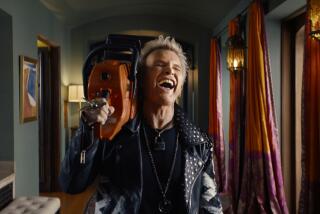Seagram Bucks Voluntary Ban on TV Advertising With Spot on Cable
- Share via
Jos. E. Seagram & Sons broadcast a liquor commercial on cable television recently, a move seen as a step toward trying to loosen the 48-year-old voluntary industry code that bans spirits from being advertised on TV.
The spot for Crown Royal, a Canadian whiskey, was broadcast during a little-watched equestrian event on the Prime Sports network in March.
“This is the camel’s nose in the tent flap,” said George Hacker, director of the alcohol policies project for the Center for Science in the Public Interest. “It is obvious they put this ad on where it would barely be noticed. It is a way for them to test the water.”
Representatives of Seagram and Prime Sports said the companies have received no reaction to the commercial, which aired at midday on March 20 in Los Angeles.
The commercial is an indication of how marketers of distilled spirits are becoming more aggressive in order to reverse a 15-year sales slump. In the last year or so, spirits firms have been targeting young adults by throwing bar parties and by sponsoring events, such as an AIDS bike-a-thon.
But activists say these efforts unintentionally may be making liquor more attractive to teenagers at a time when underage drinking is on the rise.
It isn’t known how many people viewed the Seagram-sponsored equestrian event, the Crown Royal Special Reserve Grand Prix of Palm Beach, Fla. Though Prime Sports reaches 25 million homes, viewership was considerably less.
“I think we’d be lucky if we had 100,000,” said Karen Hunter, the show’s producer.
Gina Johnson, a spokeswoman for the event, said fans of the sport range in age from mid-20s to 50s, not the teenage audience activists worry about most with alcohol advertising.
“If beer and alcohol can advertise, why not liquor?” Johnson said.
The 30-second Crown Royal spot showed a large dog with a certificate in its mouth. The on-screen caption read, “Obedience school graduate.”
After that, a second dog appeared holding a purple Crown Royal pouch. The caption: “Valedictorian.”
Seagram described the spot as a “message” during a sponsored event, not a commercial. Though the voluntary code bars commercials, it permits event and program sponsorship, as in the case of public television programs.
Elizabeth Board, director of the Distilled Spirits Council, said she couldn’t comment on whether the Seagram spot violated the code. She said the council’s advertising review committee hasn’t been contacted about it.
“I don’t think it is an issue,” she said.
Seagram said it has no plans to use the Crown Royal spot again or to air a TV commercial for any of its other brands, which include Absolut vodka.
The firm, along with other spirits companies, has been struggling to reverse steep sales declines. Liquor consumption has skidded 40% since its peak in 1979 as drinkers have shifted to wine and beer. Crown Royal has fared well in a harsh selling climate, averaging annual 5% sales gains during the last five years.
Dan Bolton, publisher of the Beverage Bulletin, said some people in the industry blame the overall sales losses on the prohibition on TV advertising. But Bolton said he believes that lifting the ban would be a mistake because it would invite government controls.
“I’m concerned that Seagram is doing something that may lead to more stringent regulation,” Bolton said. “They are waving a red flag to people concerned about liquor advertising.”
Indeed, activist organizations including the Center for Science in the Public Interest are lobbying for federal legislation that would put new restrictions on how liquor is marketed. They want alcohol ads to contain rotating warnings, similar to those in cigarette ads.
At the same time restrictions have been relaxed in Canada, where Seagram is based. The Assn. of Canadian Distillers last year won a legal challenge to a broadcast ban on liquor advertising.
Though the ban has been in existence for decades, it has been modified over the years to give spirits companies greater freedom. In 1988, the voluntary code was relaxed to allow distillers to market “spirits coolers” on TV. None of the networks accepted ads for the coolers at the time.
Seagram isn’t the first spirits company to skirt the ban. Dome Importers has aired Spanish-language spots for its brandy on the Telemundo network, arguing that liquor advertising is accepted in Latin countries.
More to Read
The complete guide to home viewing
Get Screen Gab for everything about the TV shows and streaming movies everyone’s talking about.
You may occasionally receive promotional content from the Los Angeles Times.






